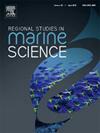Assessing meroplankton assemblage interannual variations in the Southern Yellow Sea, China: Key environmental factors and climate-related drivers
IF 2.1
4区 环境科学与生态学
Q3 ECOLOGY
引用次数: 0
Abstract
Meroplankton significantly influences both benthic and pelagic ecosystems. This study investigates interannual variations of meroplankton in the Southern Yellow Sea (SYS), China, during summertime from 2012 to 2023 (noncontinuous), focusing on the interannual variations of key groups and their environmental factors under climate change. Findings revealed that meroplankton abundance was lower in June than in July, with peak abundances recorded in 2013 for June and 2012 for July, respectively. Spatial distribution patterns showed higher abundance in coastal shallow waters (<50 m) and lower in the Yellow Sea Cold Water Mass (YSCWM) (>50 m). Gastropoda and Bivalvia larvae were the most predominant and widely distributed groups, while body length of Bivalvia larvae varied across the surveyed periods; Gastropoda and Polychaeta larvae exhibited minimal differences. Brachyura and Echinodermata larvae showed no significant body length variations. Key environmental factors affecting meroplankton included sea bottom temperature (SBT), sea bottom salinity (SBS), and depth. Notably, SBT correlated positively with increased abundance of most groups, whereas SBS and depth were associated with decreased abundance. This study reveals the broad influence of the Pacific Decadal Oscillation (PDO) on the meroplankton abundance in the Yellow Sea, to which echinoderm larvae show significant sensitivity. This research highlights the significant interactions between environmental factors and meroplankton dynamics, providing valuable insights into their ecological roles in response to climate change in the SYS. By elucidating these relationships, the study enhances our understanding of meroplankton ecology and benthic-pelagic coupling, positioning meroplankton as important ecological indicators for assessing the impacts of climate change on marine ecosystems.
南黄海浮游生物群落年际变化评估:关键环境因子和气候相关驱动因素
浮游生物对底栖和远洋生态系统都有显著影响。本文研究了2012 - 2023年夏季(非连续)南黄海浮游生物的年际变化,重点研究了气候变化下关键类群及其环境因子的年际变化。6月浮游生物丰度低于7月,2013年6月和2012年7月浮游生物丰度最高。空间分布格局表现为沿海浅海(<50 m)丰度较高,黄海冷水团(>50 m)丰度较低。腹足类和双壳纲幼虫是最占优势且分布最广的类群,双壳纲幼虫的体长在调查期间变化较大;腹足类和多毛纲幼虫差异极小。短肢目和棘皮目幼虫体长变化不显著。影响浮游生物的主要环境因子包括海底温度(SBT)、盐度(SBS)和深度。值得注意的是,SBT与大多数群体的丰度增加呈正相关,而SBS和深度与丰度下降相关。本研究揭示了太平洋年代际涛动(PDO)对黄海浮游生物丰度的广泛影响,其中棘皮类幼体表现出显著的敏感性。本研究强调了环境因子与浮游生物动力学之间的重要相互作用,为其在气候变化响应中的生态作用提供了有价值的见解。通过阐明这些关系,本研究增强了我们对浮游生物生态学和底-上层耦合的认识,使浮游生物成为评估气候变化对海洋生态系统影响的重要生态指标。
本文章由计算机程序翻译,如有差异,请以英文原文为准。
求助全文
约1分钟内获得全文
求助全文
来源期刊

Regional Studies in Marine Science
Agricultural and Biological Sciences-Ecology, Evolution, Behavior and Systematics
CiteScore
3.90
自引率
4.80%
发文量
336
审稿时长
69 days
期刊介绍:
REGIONAL STUDIES IN MARINE SCIENCE will publish scientifically sound papers on regional aspects of maritime and marine resources in estuaries, coastal zones, continental shelf, the seas and oceans.
 求助内容:
求助内容: 应助结果提醒方式:
应助结果提醒方式:


